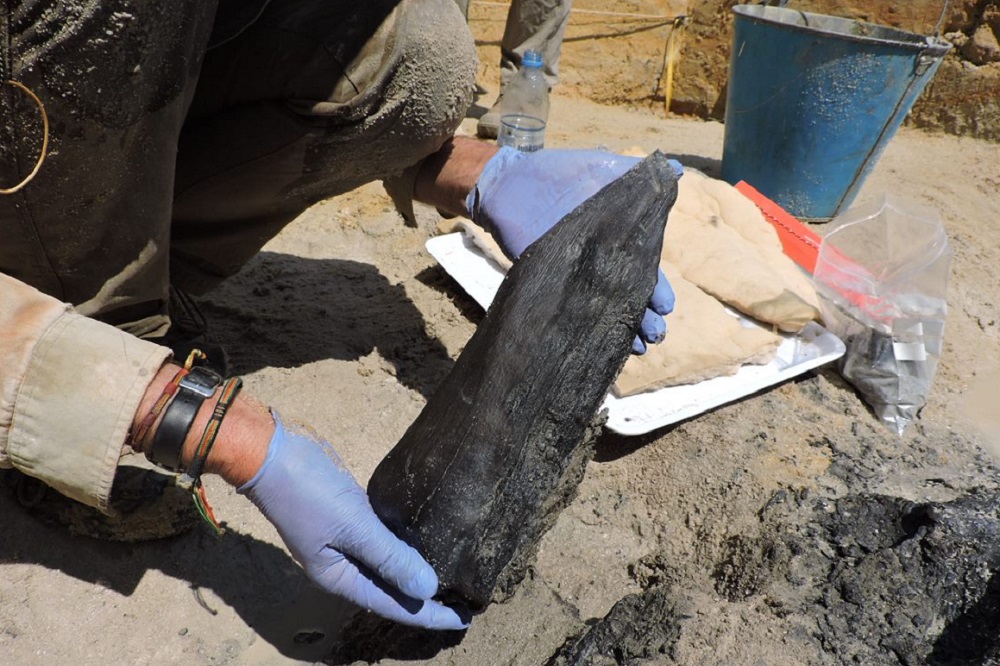Proof of Stone Age humans building wooden structures uncovered by archaeologists

Humans were building structures from wood earlier than had been thought possible, according to archaeologists who have uncovered evidence from almost half a million years ago.
Researchers from the University of Liverpool and Aberystwyth University, whose findings have been published in the journal Nature, reported on the excavation of well-preserved wood, thought to date back at least 476,000 years and pre-date the evolution of homo sapiens, at a site in Kalambo Falls, Zambia.
Experts said stone tool cut-marks on the wood show that early humans shaped and joined two large logs to make a structure, probably the foundation of a platform or part of a dwelling.
The find is the earliest evidence from anywhere in the world of the deliberate crafting of logs to fit together, the researchers said.
They believe the discovery challenges the view that Stone Age humans were nomadic.
Professor Larry Barham, from the University of Liverpool’s Department of Archaeology, Classics and Egyptology, said: “This find has changed how I think about our early ancestors.
“Forget the label ‘Stone Age’ – look at what these people were doing: they made something new, and large, from wood.
“They used their intelligence, imagination, and skills to create something they’d never seen before, something that had never previously existed.
“They transformed their surroundings to make life easier, even if it was only by making a platform to sit on by the river to do their daily chores.
“These folks were more like us than we thought.”
Luminescence dating
Experts at Aberystwyth University used luminescence dating techniques, which reveal the last time minerals in the sand surrounding the finds were exposed to sunlight, to determine the age of the finds.
Professor Geoff Duller said: “At this great age, putting a date on finds is very challenging and we used luminescence dating to do this.
“These new dating methods have far reaching implications – allowing us to date much further back in time, to piece together sites that give us a glimpse into human evolution.
“The site at Kalambo Falls had been excavated back in the 1960s when similar pieces of wood were recovered, but they were unable to date them, so the true significance of the site was unclear until now.”
This research forms part of the Deep Roots Of Humanity project, an investigation into how human technology developed in the Stone Age.
The project is funded by the UK’s Arts and Humanities Research Council and involved teams from Zambia’s National Heritage Conservation Commission, Livingstone Museum, Moto Moto Museum and the National Museum, Lusaka.
Prof Barham added: “Kalambo Falls is an extraordinary site and a major heritage asset for Zambia. The Deep Roots team is looking forward to more exciting discoveries emerging from its waterlogged sands.”
Support our Nation today
For the price of a cup of coffee a month you can help us create an independent, not-for-profit, national news service for the people of Wales, by the people of Wales.





Well done the scholars of our own Aberystwyth University for their part in this astounding discovery! This inspiring and peaceful example of technological advancement from nearly half-a-million years ago, before even the evolution of our own pridefully-named Homo-Sapiens, shows the spark that made mankind so successful. The contrast with today’s increasingly despairing rejection of and flight from our capacity to adapt through the conscious evolution of brain-power, unique amongst the animals, is shocking and painful. The technology that has lifted us as a species out of the hopeless morass of primitive survival into the Enlightened heights of advanced civilisation is… Read more »
Are these the same people who beat Archimedes by nearly half a million years…
Intriguing hint. Can you satisfy my ignorant curiosity?
Log boats, dug out canoes, imagination…
Thanks, I get it. They are indeed the primaeval giants on whose shoulders we have been hoisted, like babies to get an easy ride and see further!